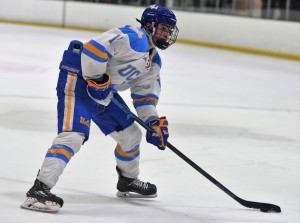WCHC bulks up to 17 teams for 2022-23 college hockey season

The face of collegiate club ice hockey in California and Arizona has undergone a major facelift for the 2022-23 season, and the West Coast Hockey Conference (WCHC) appears to be the prime beneficiary.
The WCHC, which operates at the American Collegiate Hockey Association (ACHA) men’s Division 2 level, has gone from nine members to 17 members seemingly overnight with the addition of eight incoming programs.
“UCLA and USC going to the Big Ten (in college football) wasn’t the only major conference realignment this summer,” Loyola Marymount University general manager Tyler Goeckner-Zoeller said. “We were approached by a few teams that wanted to join the WCHC and it snowballed to adding eight new teams to the conference.”
 Returning teams to the WCHC from the 2021-22 season include defending conference champion Loyola Marymount, Long Beach State, CSU Bakersfield, UC Santa Barbara, CSU Fullerton, Cal Lutheran, Chapman University and UC Irvine.
Returning teams to the WCHC from the 2021-22 season include defending conference champion Loyola Marymount, Long Beach State, CSU Bakersfield, UC Santa Barbara, CSU Fullerton, Cal Lutheran, Chapman University and UC Irvine.
CSU-Northridge, which did not compete last season, also returns to WCHC action for the upcoming season.
Notable expansion members include UCLA, Northern Arizona University, Arizona State University and Grand Canyon University. UCLA and Arizona State were both members of the Pac-8 last season.
The WCHC retains its two-tier format but is now essentially comprised of three groups.
Tier 1 includes the six top-ranked teams: LMU, Long Beach State, Northern Arizona, UCLA, ASU and GCU. Goeckner-Zoeller calls the grouping “a very tough division.”
The Tier 2 South Division will include seven teams: CSU-Northridge, UC Santa Barbara, CSU Fullerton, CSU Bakersfield, Chapman University, UC Irvine and Cal Lutheran.
The Tier 2 North Division includes the four newly added programs from Northern California: Santa Clara University, Santa Rosa Junior College, UC Davis and UC Santa Cruz.
The conference playoffs, which by will hosted by UCLA at The Cube Santa Clarita, will include 10 teams — all six Tier 1 teams, plus the top three Tier 2 South teams and the top Tier 1 North team.
Regionals rewind
The 2022 ACHA M2 West Regional tournament featured four teams from the West Coast: WCHC champion LMU plus the University of Oregon, UCLA and ASU from the Pac-8.
The 12 participating teams were seeded No. 3 through No. 14, with the top four-seeded teams receiving first-round byes. It didn’t seem to matter where the remaining eight teams were seeded, however, as three of the four games finished in overtime with three lower-seeded teams advancing to second round of elimination games.
No. 10 ASU lost, 5-4, in overtime to No. 11 BYU in the opening play-in round while No. 8 Oregon dropped a 4-3 overtime decision to No. 13 Texas A & M to suffer early elimination.
LMU and UCLA both won games to advance in the tournament.
No. 14 LMU defeated No. 7 East Texas Baptist University, 4-2, in its opening-round game to collect the first-ever regional victory in program history. The Lions (19-7-1) ended their season in the next round with a 6-4 loss to No. 3 University of Providence, which went on to qualify for the national championship tournament.
LMU, the lowest-seeded team in the regional tournament, likely pulled off the biggest upset in the play-in round braced by two goals from Spencer Engstrom and single tallies by Christopher Manzer and Connor Kilkenny.
Austin Billings and Engstrom scored early on to narrow the score against Providence to 3-2 before Providence, the tournament’s top seed, rang off the opening three goals of the third period to advance its lead to 6-2.
LMU made the game interesting with late goals by Billings (his second of the game) and William Chisholm. Billings led the Lions and their eight graduating seniors in the team’s season finale with two goals and one assist; goaltender Jason Footlick (23 saves against ETBU, 29 saves against Providence) finished as the program’s all-time wins leader.
“For LMU, last season was a great one,” Goeckner-Zoeller said. “The team won its first WCHC title, going undefeated in league play, securing the league automatic bid and a No. 14 rank for the regionals.”
No. 6 UCLA, the highest seeded Pac-8 team at the regionals, carried the torch for the four West Coast teams all the way to the semifinals, falling two goals short of advancing to the national championship tournament.
 The Bruins, after receiving a first-round bye, opened the tourney with 6-3 second-round win over No. 9 Weber State to earn a berth in the semifinals. Johnny Ilvento notched a hat trick while teammate Severin Nilsson added a goal and two assists. Jake Kovinsky stopped 29 of 32 shots to pick up the win between the pipes.
The Bruins, after receiving a first-round bye, opened the tourney with 6-3 second-round win over No. 9 Weber State to earn a berth in the semifinals. Johnny Ilvento notched a hat trick while teammate Severin Nilsson added a goal and two assists. Jake Kovinsky stopped 29 of 32 shots to pick up the win between the pipes.
The victory advanced to Bruins to a meeting with Providence, fresh off its win over LMU. UCLA definitely showed its competitiveness with a 5-4 loss to bow out of the tournament in begrudging fashion.
The Bruins led, 2-1, after the first period on goals by Justin Kaufman and Alexander Moroz but trailed 4-2 entering the final period. Duke Fishman, UCLA’s regular season scoring leader, narrowed the Providence led to 5-3 off a pass from teammate Billy Zegras at 14:16 of the final period. The Bruins forced a tense finish when Nilsson scored a power-play goal at 18:16.
UCLA turned on the heat in the third period with a 17-7 shot advantage but ran out of time in a bid to send the game into overtime despite piling up a 38-28 edge in shots in regulation. The Bruins finished with a final 18-3-1 record.
UCLA head coach Griffin McCarty and assistant coach Sean Allen attributed the Bruins’ success to the large group of incoming talent. About 40 players participated in tryouts.
“We got a lot of good kids in,” McCarty said. “Our depth, the talent of the guys. We’ve been able to rely on different guys each night. We were solid defensively.”
“A lot of guys bought in, we played as a team,” Allen chipped in.
UCLA’s top 10 scorers in 2021-22 included Fishman (22 goals, 46 points) on top, followed by Ilvento (19 goals, 35 points), Nilsson (13 goals, 33 points), Owen Sweeney (12 goals, 31 points), Alex Setteducati (13 goals, 24 points), Zegras (seven goals, 19 points), Jonathan Alterman (12 goals, 16 points), Cameron Khuong (six goals, 16 points), Moroz (six goals, 16 points) and Maximillian Chu (four goals, 14 points).
Ilvento and Zegras were the team’s top scoring defensemen.
LMU, UCLA and ASU all should be vying to earn a place in the 2023 regionals, making the upcoming WCHC season filled with intrigue and suspense.
“We graduated a lot of good players but look to have another strong season after bringing in a very strong group of players with 12 new additions to the team — eight freshmen and four transfers/grad students,” Goeckner-Zoeller said .
Puck drop
Long Beach State and LMU faced off the 2022-23 season Sept. 23 at Skating Edge Arena in Harbor City. The Lions roared to a 6-2 victory on the strength of goals by six different players: Connor Kaczmarek, Sebastian Cigarran, Manzer, Adam Nishino, Bryson Martin and Ryan Brown.
LMU was set to embark on its first Northern California road swing with games against San Jose State Sept. 30 and Oct. 1 at Solar4America Ice and against Cal-Berkeley Oct. 2 at the Oakland Ice Center.
The first big showdown in the conference is expected Oct. 7 at The Cube Santa Clarita when defending WCHC champion LMU takes on ACHA M2 West Region semifinalist UCLA.
LMU has scheduled its annual Teddy Bear Toss game Dec. 3 at Skate Edge Ice Arena against C-SUN.
The WCHC championship playoffs are scheduled Feb. 10-12. The 2023 ACHA M2 regionals are scheduled Feb. 23-25.
Aztec Nation
The San Diego State University Aztecs helped set the facelift in motion when they were green-lighted, along with fellow PAC-8 member Oregon, to move up to Division 1 status for the 2022-23 season. As a result, the Aztecs and Ducks will compete as independents in their first Division 1 season.
 “My goal in advancing this program up to D1 was to open a door for California players playing out of state to have a high-caliber collegiate program to come home to play for during their college hockey years,” SDSU head coach Phil Bateman said.
“My goal in advancing this program up to D1 was to open a door for California players playing out of state to have a high-caliber collegiate program to come home to play for during their college hockey years,” SDSU head coach Phil Bateman said.
The Aztecs are the lone ACHA Division 1 men’s team in California, which has already helped promote in-state recruiting. Of the team’s inaugural Division 1 recruiting class of 10 players, six hail from the Golden State. Altogether, the Aztecs boast 16 Cali natives on their 25-man roster.
“There’s more reasons to be here than not to be here, the beach, the school, it’s a fun place,” San Jose native Alex Xinos said. “I think I’ve checked all my boxes. I’m super excited to be here. I can’t wait to make an impact.”
San Jose’s Ishaan Khatkar, who had played AAA hockey in California before joining the Aztecs, echoed the words of his Bay Area compatriot.
“It’s a great school, great place, you can’t beat the beaches and they have hockey,” Khatkar listed as his reasons for coming to SDSU.
“I wasn’t sure I was going to play hockey this year, but SDSU was at Division 1, so I thought I’d like to give it a shot and I’m here. I want to help the team win at a brand new level, make sure we can be the best we can be, do anything I can to help.”
SDSU will be looking to develop Division 1 rivalries with Arizona State University, Grand Canyon University, University of Nevada-Las Vegas, University of Colorado-Boulder, Colorado State University and the University of Utah, all of which constitute a geographic fit for future conference play and are on the Aztecs’ 2022-23 schedule.
SDSU will be eligible for the ACHA Division 1 national tournament in its inaugural season, Bateman said.
“The only criteria provided by the ACHA is that we have a minimum of 20 ACHA D1 games on our schedule, and we have 26 scheduled,” the Aztec bench boss explained. “In our first season, qualifying isn’t a goal yet. It would be a wonderful outcome, but we have a realistic outlook on the transition to ACHA D1. This is a reset to our new two-to-three-year plan. Once we have a couple of recruiting classes at this level, we expect to be a very competitive program on the national stage.”
The ACHA season runs through March.
SDSU posted a 12-5-0-0-1 record (12 wins, five losses, one tie) in their final season at the ACHA Division 2 level, their third in Pac-8 play.
“Our collective goal this year will be to continue to grow and develop as a program,” Bateman said. “Our on-ice goals have never changed. We look to focus on skill growth, systems implementation and set the standards of play for the team. In parallel, we will look to continue to increase our footprint and influence within the San Diego and California hockey landscape.”
The Aztecs faced off their inaugural Division 1 season with a pair of home games Sept. 23-24 against Colorado-Boulder. The visiting Buffaloes prevailed, 3-1, in a defensive game in the series opener and out-scored the hosts, 9-6, in a more free-wheeling game in the series finale.
Danville’s Lucas Bellig came out of the weekend set as the Aztecs’ early season scoring leader with five assists.
“Winning and losing are not on our radar,” Bateman said “We will do things the right way and the results will be the results. The focus is to know what we are working towards; understanding it is a longer-term plan.”
Nationwide
The ACHA serves as the governing body for non-NCAA men’s and women’s ice hockey in the United States.
Overall, the ACHA has grown with at least 24 new members for the 2022-23 season, including six in men’s Division 2, nine in men’s Division 3 and five in women’s Division 1.
 ACHA executive director Craig Barnett said the men’s ACHA Division 1 level continues to build on the West Coast.
ACHA executive director Craig Barnett said the men’s ACHA Division 1 level continues to build on the West Coast.
During the past 2021-22 season, ACHA membership comprised 454 teams in five divisions, of which 435 actually competed coming off the shortened 2020-21 season because of the COVID-19 pandemic.
Sixty-eight teams competed in Men’s Division 1 in 2021-22. The men’s Division 2 was the largest division with 187 teams, followed by men’s Division 3 with 97 teams, women’s Division 1 with 29 teams and Women’s Division 2 with 54 teams.
Men’s Division 1 will have 70 teams for the upcoming season with the addition of four teams from the M2 division (SDSU, Oregon, Purdue University Northwest and College of New Jersey) and two teams (Iowa State and Lindenwood University) not fielding M1 teams this season.
The W1 division will now include 34 teams, the highest number in that division since the 2006-07 season.
Photos/Phillip Brents
– Phillip Brents
(September 30, 2022)










